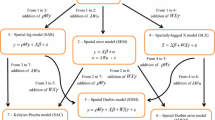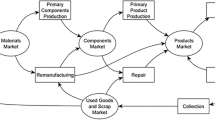Abstract
It is demonstrated herein that a slight expansion of the utility function in the duopolistic Hotelling game enables any symmetric location pair with respect to the center to be in equilibrium, which implies that any level of locational differentiation between the minimum Hotelling (Econ. J.39:41–57, 1929) and maximum D’Aspremont (Econom. 47:1145–1150, 1979) is obtained in one model. The location equilibrium is monotone with respect to the introduced parameter (k), while the equilibrium price and profits are not monotone (they are U-shaped). That is, the nearer the two firms are located, the higher their prices are set (with an upper limit) when k is sufficiently large. This counterintuitive phenomenon is interpreted as an example of strategic complementarity that is inherent in the Hotelling games.



Similar content being viewed by others
Notes
See, for example, Caplin and Nalebuff (1991) for a comprehensive analysis of the existence of equilibrium.
One may think that t is the same role in the first place. However, t does not affect the location equilibrium in D’Aspremont et al. (1979), and we will see that k matters for the equilibrium. Further, regarding price sensitivity, Puu (2002) dealt with an elastic demand in the Hotelling game and also showed the various location equilibrium values. In their model, the demand function is linear: \(f(z)=\alpha -\beta z\), where \(z=p+td\) is the linear full cost.
We readily find that the second-order conditions are satisfied for the equilibrium.
We can easily confirm that the second-order conditions are satisfied (\(\partial ^2 \pi _i/\partial p_i^2<0\)).
See Appendix for the details.
References
Caplin, A., Nalebuff, B.: Aggregation and imperfect competition: on the existence of equilibrium. Econometrica 59, 25–59 (1991)
D’Aspremont, C.J., Gabszewicz, J., Thisse, J.-F.: On Hotelling’s stability in competition. Econometrica 47, 1145–1150 (1979)
Dragone, D., Lambertini, L.: Equilibrium existence in the Hotelling model with convex production costs. Reg. Sci. Urban Econ. 84, 103568 (2020)
Egli, A.: Hotelling’s beach with linear and quadratic transportation costs: existence of pure strategy equilibria. Aust. Econ. Pap. 46, 39–51 (2007)
Hotelling, H.: Stability in competition. Econ. J. 39, 41–57 (1929)
Lambertini, L.: Equilibrium locations in the unconstrained Hotelling game, Quaderni - Working Paper DSE, No. 155, Alma Mater Studiorum - Universita diBologna, Dipartimento di Scienze Economiche (DSE), Bologna, (1993) https://doi.org/10.6092/unibo/amsacta/5202
Puu, T.: Hotelling’s “Ice cream dealers’’ with elastic demand. Ann. Reg. Sci. 36, 1–17 (2002)
Acknowledgements
The author is grateful for the helpful comments of two anonymous referees, which improved the quality of this publication. All remaining errors are my own.
Author information
Authors and Affiliations
Corresponding author
Additional information
Publisher's Note
Springer Nature remains neutral with regard to jurisdictional claims in published maps and institutional affiliations.
Appendices
Appendix
On Proposition 2
We have \(\partial \pi _1/\partial x_1=\,g_0\cdot g_1\) and \(\partial \pi _2/\partial x_2=\,g_0\cdot g_2\), where
Therefore, the first-order conditions \(\partial \pi _i/\partial x_i=0\) degenerate into \(g_1=0\) and \(g_2=0\). Solving the two equations yield (13) in the proposition. Evaluating the second derivative \(\partial ^2 \pi _i/\partial x_i^2\) at Eq. (13), we have:
which implies that the second-order conditions are satisfied.
On \({\tilde{k}}\)
Let f(k) be the right-hand side of Eq. (16). We can easily have \(df(k)/dk>0\) with \(\lim _{k\rightarrow 0} f(k)=-\infty\) and \(\lim _{k\rightarrow \infty } f(k)=\infty\). This implies that there exists a unique solution for Eq. (16) for any \(t\in (0,\infty )\), and we also find \(d{\tilde{k}}/dt=(2k^4+14k^3+29k^2+24k+8)/k(k^2+3k+2)^2>0\).
Rights and permissions
Springer Nature or its licensor (e.g. a society or other partner) holds exclusive rights to this article under a publishing agreement with the author(s) or other rightsholder(s); author self-archiving of the accepted manuscript version of this article is solely governed by the terms of such publishing agreement and applicable law.
About this article
Cite this article
Ago, T. Utility function and location in the Hotelling game. Lett Spat Resour Sci 16, 21 (2023). https://doi.org/10.1007/s12076-023-00344-w
Received:
Accepted:
Published:
DOI: https://doi.org/10.1007/s12076-023-00344-w




